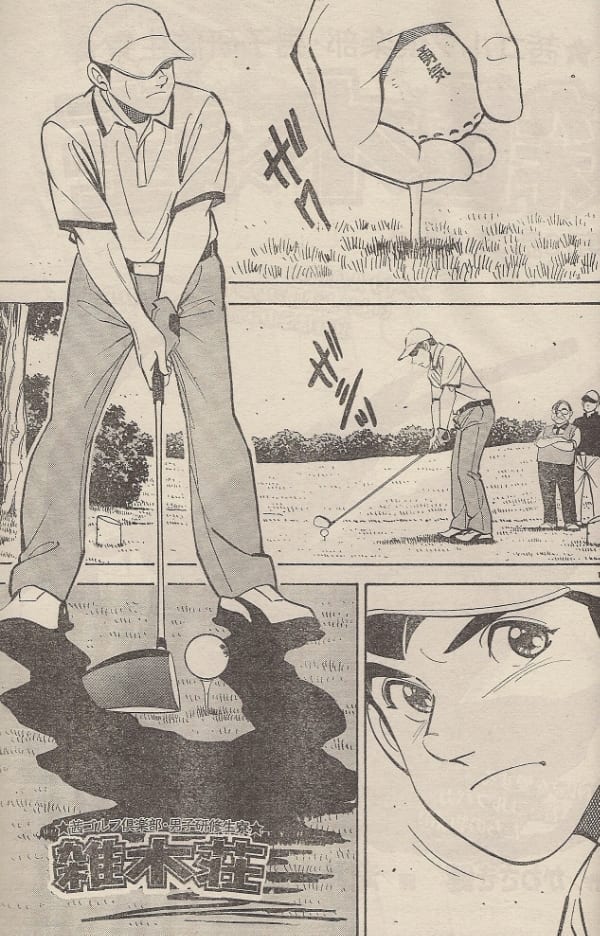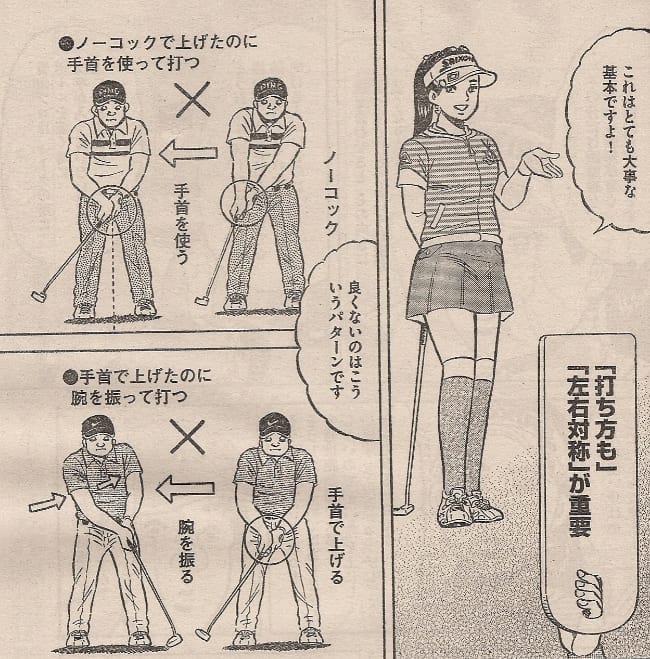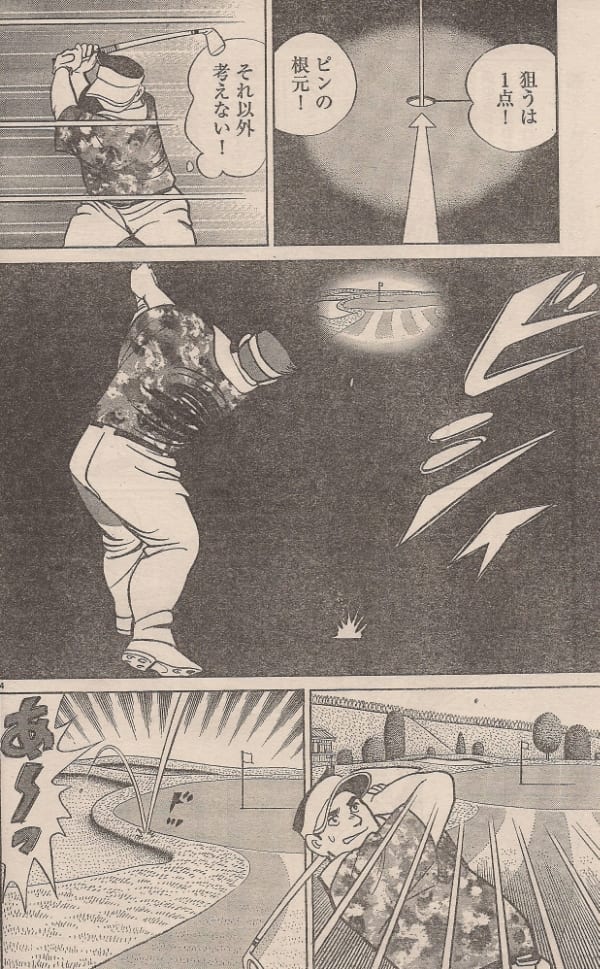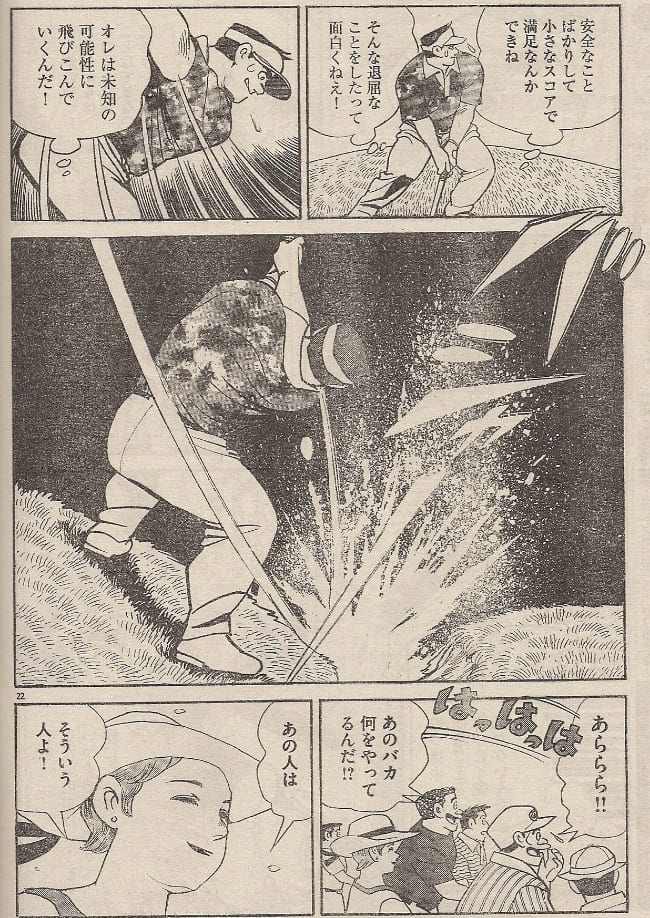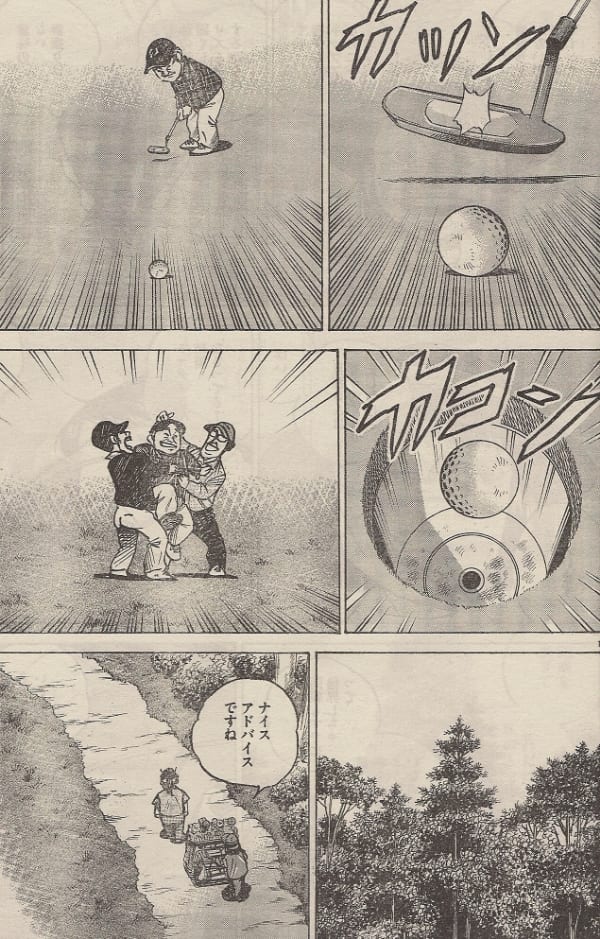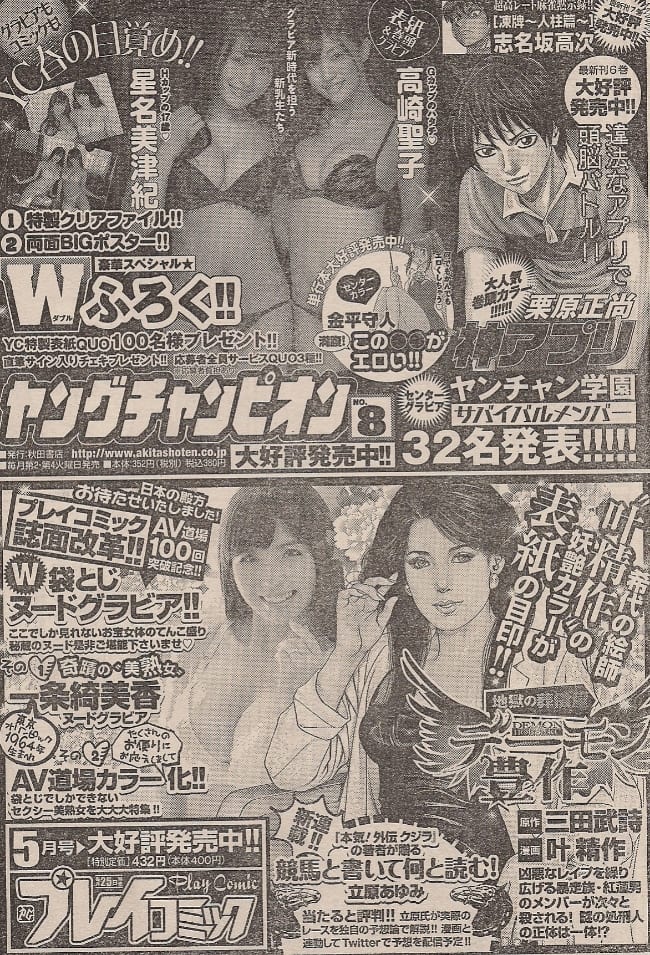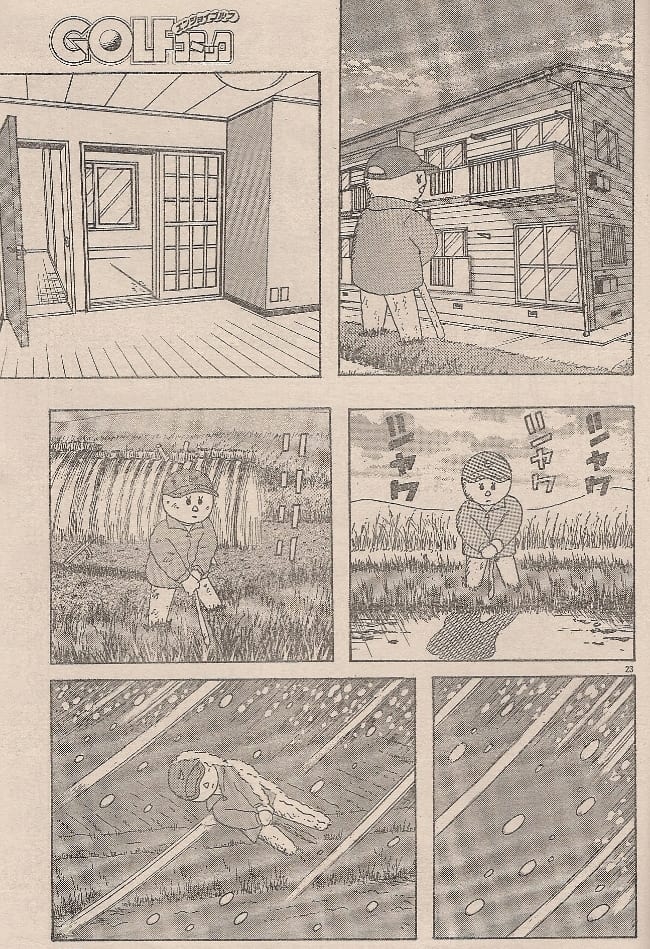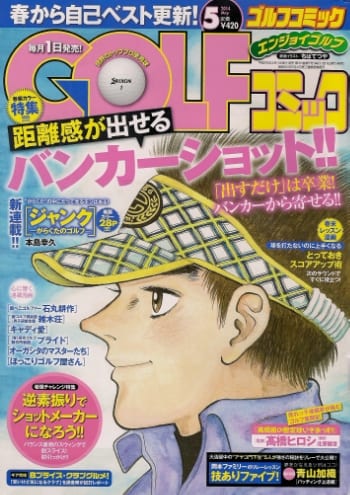 I swear before god and country that I was looking for something classy. Something artistic and progressive: exciting. I'd heard the January issue of Geijutsu Shincho had a really cool Yoshiharu Tsuge feature, for example, but all I could find at the Manhattan Kinokuniya were lifestyle glossies like Popeye ("Magazine for City Boys") and a weird proliferation of Moomin merchandise - blankets stuffed in cardboard boxes, smartphone cases, etc. My eyes scanned the shelves. Model gun magazines. Art and design magazines. Sports magazines, and--
I swear before god and country that I was looking for something classy. Something artistic and progressive: exciting. I'd heard the January issue of Geijutsu Shincho had a really cool Yoshiharu Tsuge feature, for example, but all I could find at the Manhattan Kinokuniya were lifestyle glossies like Popeye ("Magazine for City Boys") and a weird proliferation of Moomin merchandise - blankets stuffed in cardboard boxes, smartphone cases, etc. My eyes scanned the shelves. Model gun magazines. Art and design magazines. Sports magazines, and--
WITNESS: the obliquely-titled Golf Comic. Not racked with the rest of the manga magazines, oh no - this is a proper monthly sports publication in the eyes of Kinokuniya, albeit one released by the manga specialists at Akita Shoten and consisting of roughly 80% comics content. It could be that marketing realities prevent the chain from pressing this sort of item into the same hands clamoring for the latest shōnen and shōjo favorites, because why would they care? This is 300 pages of GOLF COMICS, and, while it's generally recognized that the friendship/perseverance/victory ethos of contemporary gotta-be-the-best Japanese boys' comics evolved from the hot-blooded guts on display in Star of the Giants et al., the realities of golf in Japan as a class-coded aspirational pursuit -- "In a country whose hinterland is largely mountains and forests, where so much habitable space has had to be wrestled bodily from the sea, the idea of eighteen stretches of land set aside for a mere game is the height of conspicuous consumption," Jonathan Clements, Schoolgirl Milky Crisis -- mark this particular sporting content as 'old folks all the way.' Old men, if we're honest.
Still - look at that cover. The artist's name is Toshiki Takii, who's been active in sports comics since at least the early 1990s, and he's working a very clean, angular style. A bit retro, once you get a look at the clothes and everything.
Make no mistake, though - there is a lot in Golf Comic that strives to be current. All but two of the magazine's color pages go toward instructional features and advertisements, the latter promising cool shit like this:
See?! Skulls are cool! Young! Look, here's a young woman showing you "The Cool Swing":
Probably, this woman is some sort of well-known(-to-fans) professional player, as Golf Comic -- in addition to playing at youth -- also strives for authority. An unusual 52 pages (over 1/6th the magazine) are devoted to text-based features, offering everything my extremely limited reading comprehension can discern from golfing product blurbs to tournament schedules; there's even a diagrammatic journey across one specially-selected hole, in which a quartet of suspiciously photogenic players offer a boots-on-the-ground test run:
But not all of the eduction arrives in so documentary a manner. There are instructional comics too, such this piece drawn by Masaki Yamoto, an artist who's been working since the late '70s, predominantly in Akita Shoten magazines.
Golf Comic itself purportedly dates back to 1985; this would place its genesis in the midst of bubble economy extravagance, where it might have seemed a safe haven for sports manga specialists; while not quite the equivalent of a life sentence, drawing sports manga does build a certain skill set that can make an artist especially assignable to different sports serials, leading to a certain substrata of mangaka whose personal catalogs are highlighted by baseball, soccer - or sometimes mainly golf.
As you can imagine, this is a world far away from most American eyes in even the most ravenous periods of manga consumption. Years ago, however, ComiPress posted a rare English-language interview with one such practitioner: Seiichi Ikeuchi, a former assistant to the great ninja comics master Sanpei Shirato, and a true-blue golfing hobbyist who built himself over two decades' worth of golf comics output. He cannily acknowledges that this is a connoisseur's field; that most everyone reading -- presumably even the newbies who'd make use of whatever entry-level instruction a magazine's editors deem necessary -- can tell if an artist is bullshitting them, and so the most challenging aspect of the craft is "communicating the techniques to the readers through the manga."
He is, nonetheless, a stylist, as his present Golf Comic series attests:
Save for the presumably digital bouquet of the protagonist's shirt, what we're seeing here is a lot of smoothness: both in the arrow pointing to the hole, as well as from the curvature of the plastic-looking course itself, blacked out in the center tier as a means of communicating the concentration of the player as his drive issues its tiny crack. This is a calm moment.
And then, later, he finds himself on less hospitable terrain, in a more agitated state and KABOOM.
Obviously, I was showing this shit around to everyone at MoCCA last weekend, and that one panel above was the guaranteed eye-popper, every single time, because who expects to see that ejaculatory a whiteout passion in golf? The trick, I think, is that while Ikeuchi's characters are not enormously exaggerated in expression (remaining rather gekiga in disposition throughout), he can still make smart use of fundamental visual properties to convey the *texture* of the game - sudden violence spitting into calculation.
Elsewhere in his interview, Ikeuchi names Yoshinobu Numa, creator of Caddy Love, as an artist who's caught his interest. As luck would have it, both author and serial are also housed in Golf Comic, though Numa's point of view is quite different than Ikeuchi's. Instead of isolating crucial moments through in-panel variations on detail and impact, Numa instead breaks his pages down into tiers of diptychs (with occasional variations), excerpting representational instances into a simulation of time's passage. It takes a long time to hit every hole, after all.
I quite like this; characters are most often glimpsed in either full-body shot or extreme close-up, alternating between distance and intimacy in a way which strikes me as conceptually sound, given the process of golfing - even the trees are given some time to themselves. It's not quite Mitsuru Adachi, but it works to say something about the activity in a holistic manner.
All of these golf comics, incidentally, involve golfing. This seems obvious, but how many superhero comics are out there today in which the characters are merely plotting and conversing for 20 pages? None of that here - there's active golf being played in *every* feature, and just as many tricks for depicting golf. Here, Sadayoshi Ishii demonstrates that Yuichi Yokoyama was not conceived in a vacuum:
And take note too of that whisper of hip, 'cause aside from a one-panel masturbation gag in a 4-koma strip, that's the most sex you'll be getting out of Golf Comic. Unless you count the in-house solicitations.
No, these aren't the escort ads in the back of your local alternative weekly - they went out of business years ago! (The weeklies, not the escorts.) Akita Shoten, in contrast, publishes nineteen manga magazines, few of which disabuse themselves of the notion that sex fucking sells - Young Champion is up top, and Play Comic is down bottom, the latter a classically virile hodgepodge of sexy girls and cigars & whisky fare like horse racing. And lest you think we are growing exclusively chauvinistic -- though manga magazines are loath to cross the streams of gender targeting -- there is also the LoveMAX line of josei manga, which I understand to be a bit closer to an earlier reading generation's idea of redikomi, i.e. "ladies comics," i.e. bang-on smut.
Why is this? I mean, even Weekly Shōnen Champion, the publisher's flagship boys' comic, once served as home to the disreputable likes of Gō Nagai's Cutie Honey, and later such notorious exercises in so-risible-they-can't-be-serious titillation as Eiken. Fucking Eiken! Did I just happen to catch Golf Comic on a low-simmer month? Do older guys get less interested in this stuff? Is Golf Comic the oldest of them all?
Or--
There's this one artist - Takeshi Arima, another one who's been around since the '70s. He's done fishing comics, mahjong comics, baseball comics, and golf. He draws really round, squat characters, and in this issue of Golf Comic he's either working with a writer or adapting somebody else's story - a parable of sorts, about a man who doesn't seem to have a lot of friends, working in isolation all the time. And there's this scarecrow outside the building where he's found himself lodged, and since the guy can't really play golf out there in the sticks, he dresses the scarecrow up in his golfing gear and gets to talking with it. And more and more, the scarecrow looks human, until finally the man gets to leave his apartment complex, presumably to better realize his golfing dreams, and the scarecrow, only an item after all, lays cold and forgotten.
"It's like The Giving Tree!" Chris Mautner exclaimed, on the train back from MoCCA. I was taken aback by this unprecedented level of interest in my goofy Kinokuniya purchases, but he had a point. Is the dream of golf a higher calling, which provides for the spirit in times of struggle, or is it only mysticism and import attached to the selfish pursuit of consumable objects? Will this man return in his advanced age, to rest himself against the scarecrow golf pro, and will the pro be happy?
Damn, this is a classy comic!
***
PLEASE NOTE: What follows is not a series of capsule reviews but an annotated selection of items listed by Diamond Comic Distributors for release to comic book retailers in North America on the particular Wednesday identified in the column title above. Be aware that some of these comics may be published by Fantagraphics Books, the entity which also administers the posting of this column. Not every listed item will necessarily arrive at every comic book retailer, in that some items may be delayed and ordered quantities will vary. I have in all likelihood not read any of the comics listed below, in that they are not yet released as of the writing of this column, nor will I necessarily read or purchase every item identified; THIS WEEK IN COMICS! reflects only what I find to be potentially interesting.
***
SPOTLIGHT PICKS!
Turning Point: 1997-2008: If this 400-page prose-based Viz hardcover is anything like its predecessor, 2009's translation of Starting Point: 1979-1996, we're really going to be in for a treat here. Dense, scattered, tetchy and almost bottomlessly informative, Starting Point (also available this week as a $16.99 paperback) was a compilation of writings by Hayao Miyazaki -- plaudit-for-plaudit and dollar-for-dollar probably the most successful (frustrated!) comics artist ever to work in filmmaking -- which formed both an autobiography, a philosophy of creation, an apologia for creation, and a subjective chronicle of an animation industry constantly in danger of buckling under the weight of its own spurts in popularity. I expect nothing less here, as Miyazaki enters a period of increasingly phenomenal nationwide celebrity and international acclaim; we almost never get first-person accounts of anime or manga history in English, so press this one right against your bosom. Translation by Beth Cary & Frederik L. Schodt; $29.99.
What Did You Eat Yesterday? Vol. 1: Oh, but Miyazaki is no more indicative of anime as a whole than Golf Comic is of seinen manga. No, the real meat & potatoes stuff would have to be cooking manga, of which virtually every general mature audiences magazine boasts a few. And while I'm certain Vertical is right now working on a plan to get all 1,276 installments of Cooking Papa into deluxe hardcover format, for now we'll have to do with this ongoing series by the hugely respected Fumi Yoshinaga of Antique Bakery and Ōoku: The Inner Chambers, concerning the small dramas in the shared life of two gay men, and the meals that get made in spite of everything else. Recipes in-story; $12.95.
--
PLUS!
Cosplayers: Are you ready for alternative comic books? Because that's what Fantagraphics is bringing this week - 32 pages of quixotic color story and pinups, set in the vivified world of costume play, written and drawn by Dash Shaw. Deep thoughts on anime, hidden cameras, online haters, romance, lies and public beatings: everything you want. Preview; $4.99.
Big Nate: Great Minds Think Alike: This is another collection of creator Lincoln Peirce's nearly quarter-century-old comic strip, which, despite the decline of newspapers, has staked out territory among the bestselling comics of any type in bookstores today; at the absolute minimum, I think this series sold 300,000 copies last year, and that's not even counting lucrative kid-targeted venues like book fairs. As always, it's from Andrews McMeel, 224 pages at 6" x 9". Official site; $9.99.
All-New Ultimates #1: It's another week, and Marvel's got another crop of debut issues, this time a youthful revival of their alternate continuity super-team concept, as written by Copra creator (and sometimes Journal contributor) (and, fullest disclosure, my friend) Michel Fiffe. The issue is drawn by Amilcar Pinna and colored by Nolan Woodard. Preview; $3.99.
All-New Doop #1: There's continuing series due as well, like issue #2 of the Felipe Smith/Tradd Moore-fronted Ghost Rider revival, but I'd be remiss to neglect to mention this long-term continuation - the return of writer Peter Milligan to the ominous/whimsical green blob character he co-created with Mike Allred way back in 2001, when superhero comics seemed a bit more reckless. M. Allred is drawing Silver Surfer now, so David Lafuente subs, with Laura Allred nonetheless remaining as colorist. Preview; $3.99.
Shutter #1: And here is your obligatory good-looking Image debut, a new series from writer Joe Keatinge, purportedly poised to bring sprightly adventure and exploration. Art/color by Leila del Duca & Owen Gieni, and it already looks very accomplished. Preview; $3.50.
Megatokyo datapack: volumes 1-3: On one hand, this seems like an impossible relic from a time when major comic book publishers were willing to throw a little money at prominent webcomics people, i.e. the mid-'00s, when Dark Horse put out three books' worth of severely anime-inflected moe comedy/adventure/romance from Fred Gallagher & (initially) Rodney Caston. Then I think the property moved to various DC-affiliated studios for another three volumes, and then I totally lost track of it, since Megatokyo is resolutely Not My Thing. Still, it was undeniably one of THE webcomics for a long while, and a recent video game Kickstarter blew past its 20k goal into the six-figure region, so obviously there's still an active, appreciative fan base out there, and some of them might be interested in this 576-page Dark Horse compendium of everything they put out before, with some special extras. Samples; $19.99.
Days Of Destruction, Days Of Revolt SC: This is one of Joe Sacco's recent releases, which I think might have gotten a little lost for some readers - both because a lot books are released (Sacco had two in 2012), and because Sacco's work in here was made in conjunction with prose reportage by Chris Hedges. The broad topic is poverty and exploitation in the United States, and the book is now a 320-page softcover from Nation Books; $16.99.
Knights Of Sidonia Vol. 8: BACK TO VERTICAL! This is the latest from Tsutomu Nihei's space-faring action series, the anime adaptation of which is set to debut on Thursday; $12.95.
The Art of The Wind Rises: BACK TO VIZ! Every Studio Ghibli project these days is accompanied (eventually) by an English release of its big deluxe art book, and Miyazaki's latest is no exception. Of course, The Wind Rises differs from other Ghibli projects in its pretty explicitly adult-leaning, vignette-driven tone and pace, to say nothing of the historical content of the narrative or its central apologia for art as an inspiring force wafting above the immoral circumstances of its creation. All or none of this may be covered in the various interviews found amongst the production art samples of these 224 pages - hell, Turning Point leaves off at '08, so just as well; $34.99.
Wide Awake in Slumberland: Fantasy, Mass Culture, and Modernism in the Art of Winsor McCay: Part one of your University Press of Mississippi scholarly pairing of the week - really one of those books that leaves no doubt from the title, eh? The author is Journal contributor Katherine Roeder, who seeks to study the master "from an art historical perspective, giving close readings of individual artworks while situating his output within the larger visual culture and the rise of modernism." A 240-page hardcover, 8.5" x 11" with b&w and color illustrations; $60.00.
Komiks: Comic Art in Russia: And part two from the Press, a 280-page José Alaniz study of Russian comics art, produced under difficult conditions - "thriving in summers of relative freedom, freezing in hard winters of official disdain," per the publisher. I don't know *anything* about this subject, so it's good to know some research is out there as accessibly as this; $30.00.


